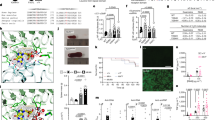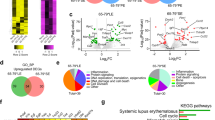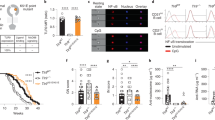Abstract
Our previous study uncovered that the overlapping region of murine lupus susceptibility Sle2c1rec1a and Sle2c1rec1d subloci is strongly associated with lymphadenopathy and systemic autoimmunity. In order to identify the specific candidate gene, we generated a novel shorter recombinant, named as Sle2c1re1d1 (rec1d1), from Sle2c1rec1d sublocus (rec1d). The rec1d1 interval corresponds precisely to the overlapping region of Sle2c1rec1a and Sle2c1rec1d subloci. Functionally, this rec1d1 sublocus showed a strong epistatic interaction with lpr, similar to that seen with Sle2c1rec1a or.Sle2c1rec1d. The Skint6 gene in the red1d1 interval was identified to have a point mutation, which inserts a premature stop codon and converts the membrane Skint6 protein into a truncated secretory peptide. However, other protein-coding genes in the rec1d1 interval have no mutation in exon sequence. The heterozygous rec1d1 interval in B6.lpr demonstrates exacerbated autoimmunity. For example, non-hematopoietic stem cell-derived cells of the B6.Sle2c1rec1d1.lpr mice promote T-cell proliferation in vivo. These findings led us to conclude that the Skint6 variant in the rec1d1 interval is the most likely causative gene of mouse lupus.
This is a preview of subscription content, access via your institution
Access options
Subscribe to this journal
Receive 6 digital issues and online access to articles
$119.00 per year
only $19.83 per issue
Buy this article
- Purchase on Springer Link
- Instant access to full article PDF
Prices may be subject to local taxes which are calculated during checkout





Similar content being viewed by others
References
Tsokos GC . Systemic lupus erythematosus. N Engl J Med 2011; 365: 2110–2121.
Perry D, Sang A, Yin Y, Zheng YY, Morel L . Murine models of systemic lupus erythematosus. J Biomed Biotechnol 2011; 2011: 271694.
Morel L, Rudofsky UH, Longmate JA, Schiffenbauer J, Wakeland EK . Polygenic control of susceptibility to murine systemic lupus erythematosus. Immunity 1994; 1: 219–229.
Morel L . Genetics of SLE: evidence from mouse models. Nat Rev Rheumatol 2010; 6: 348–357.
Mohan C . The long (and sometimes endless) road to murine lupus genes. J Immunol 2015; 195: 4043–4046.
Mohan C, Morel L, Yang P, Wakeland EK . Genetic dissection of systemic lupus erythematosus pathogenesis: Sle2 on murine chromosome 4 leads to B cell hyperactivity. J Immunol 1997; 159: 454–465.
Xu Z, Butfiloski EJ, Sobel ES, Morel L . Mechanisms of peritoneal B-1a cells accumulation induced by murine lupus susceptibility locus Sle2. J Immunol 2004; 173: 6050–6058.
Xu Z, Cuda CM, Croker BP, Morel L . The NZM2410-derived lupus susceptibility locus Sle2c1 increases Th17 polarization and induces nephritis in fas-deficient mice. Arthritis Rheum 2011; 63: 764–774.
Xu Z, Croker BP, Morel L . The combination of two Sle2 lupus-susceptibility loci and Cdkn2c deficiency leads to T-cell-mediated pathology in B6.Fas(lpr) mice. Genes Immun 2013; 14: 373–379.
Xu Z, Potula HH, Vallurupalli A, Perry D, Baker H, Croker BP et al. Cyclin-dependent kinase inhibitor Cdkn2c regulates B cell homeostasis and function in the NZM2410-derived murine lupus susceptibility locus Sle2c1. J Immunol 2011; 186: 6673–6682.
Potula HH, Xu Z, Zeumer L, Sang A, Croker BP, Morel L . Cyclin-dependent kinase inhibitor Cdkn2c deficiency promotes B1a cell expansion and autoimmunity in a mouse model of lupus. J Immunol 2012; 189: 2931–2940.
Boyden LM, Lewis JM, Barbee SD, Bas A, Girardi M, Hayday AC et al. Skint1, the prototype of a newly identified immunoglobulin superfamily gene cluster, positively selects epidermal gamma delta T cells. Nat Genet 2008; 40: 656–662.
Dai C, Deng Y, Quinlan A, Gaskin F, Tsao BP, Fu SM . Genetics of systemic lupus erythematosus: immune responses and end organ resistance to damage. Curr Opin Immunol 2014; 31: 87–96.
Theofilopoulos AN, Dixon FJ . Murine models of systemic lupus erythematosus. Adv Immunol 1985; 37: 269–390.
Morel L, Croker BP, Blenman KR, Mohan C, Huang G, Gilkeson G et al. Genetic reconstitution of systemic lupus erythematosus immunopathology with polycongenic murine strains. Proc Natl Acad Sci USA 2000; 97: 6670–6675.
Shi X, Xie C, Kreska D, Richardson JA, Mohan C . Genetic dissection of SLE: SLE1 and FAS impact alternate pathways leading to lymphoproliferative autoimmunity. J Exp Med 2002; 196: 281–292.
Croker BP, Gilkeson G, Morel L . Genetic interactions between susceptibility loci reveal epistatic pathogenic networks in murine lupus. Genes Immun 2003; 4: 575–585.
Bouillet P, O'Reilly LA . CD95, BIM and T cell homeostasis. Nat Rev Immunol 2009; 9: 514–519.
Martina MN, Noel S, Saxena A, Rabb H, Hamad AR . Double negative (DN)αβ T cells: misperception and overdue recognition. Immunol Cell Biol 2015; 93: 305–310.
Bolland S, Yim YS, Tus K, Wakeland EK, Ravetch JV . Genetic modifiers of systemic lupus erythematosus in FcgammaRIIB(-/-) mice. J Exp Med 2002; 195: 1167–1174.
Pisitkun P, Deane JA, Difilippantonio MJ, Tarasenko T, Satterthwaite AB, Bolland S . Autoreactive B cell responses to RNA-related antigens due to TLR7 gene duplication. Science 2006; 312: 1669–1672.
Subramanian S, Tus K, Li QZ, Wang A, Tian XH, Zhou J et al. A Tlr7 translocation accelerates systemic autoimmunity in murine lupus. Proc Natl Acad Sci USA 2006; 103: 9970–9975.
Xu Z, Vallurupalli A, Fuhrman C, Ostrov D, Morel L . A New Zealand Black-derived locus suppresses chronic graft-versus-host disease and autoantibody production through nonlymph bone marrow-derived cells. J Immunol 2011; 186: 4130–4139.
Sunderrajan EV, McKenzie WN, Lieske TR, Kavanaugh JL, Braun SR, Walker SE . Pulmonary inflammation in autoimmune MRL/Mp-lpr/lpr mice. Histopathology and bronchoalveolar lavage evaluation. Am J Pathol 1986; 124: 353–362.
Cai P, König R, Boor PJ, Kondraganti S, Kaphalia BS, Khan MF et al. Chronic exposure to trichloroethene causes early onset of SLE-like disease in female MRL +/+ mice. Toxicol Appl Pharmacol 2008; 228: 68–75.
Acknowledgements
This project was supported by the National Natural Science Foundation of China (Grant No. 81373185) and National Institutes of Health Grant K01AR056725 to ZX.
Author information
Authors and Affiliations
Corresponding author
Ethics declarations
Competing interests
The authors have no financial conflict of interest.
Rights and permissions
About this article
Cite this article
Xu, Z., Xu, J., Ju, J. et al. A Skint6 allele potentially contributes to mouse lupus. Genes Immun 18, 111–117 (2017). https://doi.org/10.1038/gene.2017.8
Received:
Revised:
Accepted:
Published:
Issue Date:
DOI: https://doi.org/10.1038/gene.2017.8



